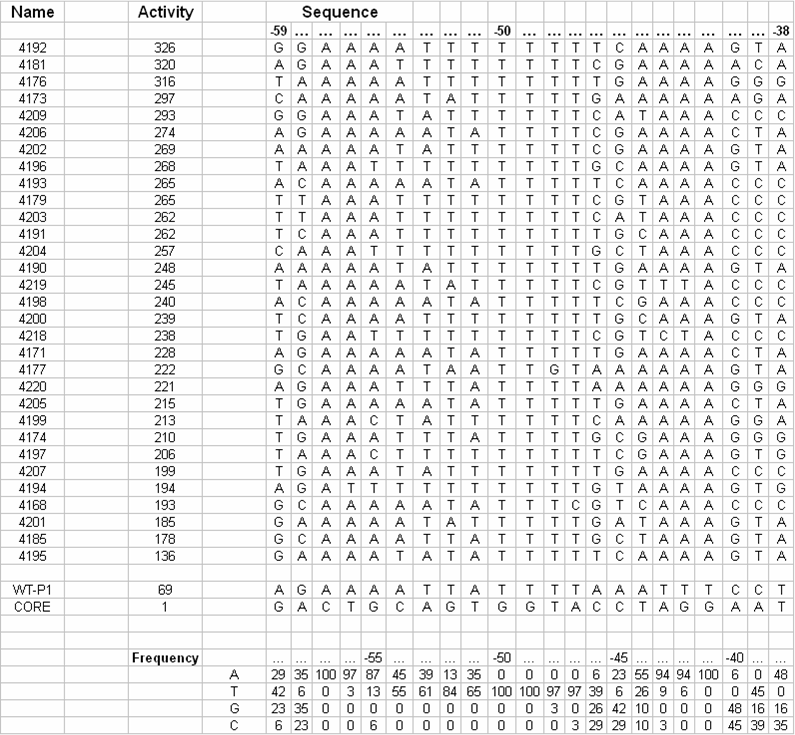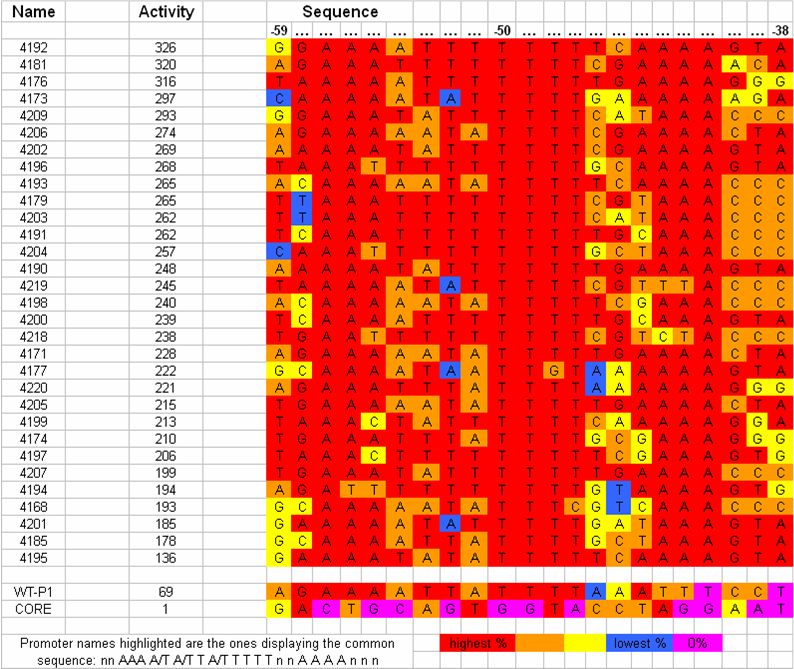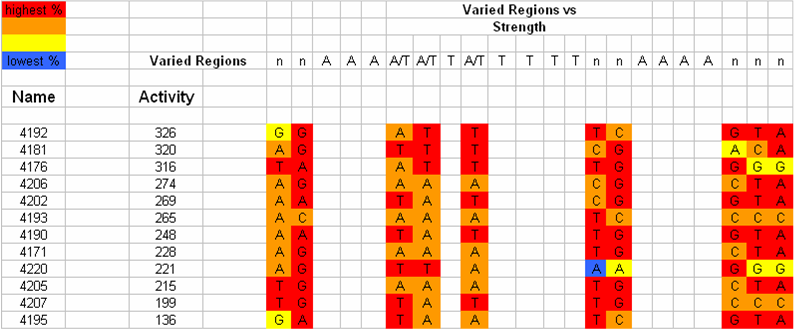Team:Virginia Commonwealth/Design
From 2009.igem.org
GMcArthurIV (Talk | contribs) |
GMcArthurIV (Talk | contribs) (→UP-element design) |
||
| Line 5: | Line 5: | ||
| | | | ||
==UP-element design== | ==UP-element design== | ||
| - | Work has been done to identify a consensus | + | UP-elements are known to significantly increase the RNA polymerase-recruiting power of promoters by interacting with the alpha subunit of RNA polymerase. Work has been done to identify a consensus sequence for this transcriptional enhancer based on 31 natural ''E. coli'' promoters (Estrem ST, Gaal T, Ross W, Gourse RL, Identification of an UP element consensus sequence for bacterial promoters, ''PNAS'', (1998), 95, 9761-9766.). |
| - | + | ||
[[Image:VCU 2009 tabulated UP-elements.png|thumb|center|400px|Tabulation of UP-elements in ''E. coli'' and nucleotide frequency at each position (adapted from Estrem ST, Gaal T, Ross W, Gourse RL, Identification of an UP element consensus sequence for bacterial promoters, ''PNAS'', (1998), 95, 9761-9766.)]] | [[Image:VCU 2009 tabulated UP-elements.png|thumb|center|400px|Tabulation of UP-elements in ''E. coli'' and nucleotide frequency at each position (adapted from Estrem ST, Gaal T, Ross W, Gourse RL, Identification of an UP element consensus sequence for bacterial promoters, ''PNAS'', (1998), 95, 9761-9766.)]] | ||
| + | |||
| + | |||
We are working on creating this UP element as a modular BioBrick part and characterizing its activity using the promoter characterization method that we develop. We will also manipulate this element using a bottom-up design approach to get UP elements of varying degree's of strength. Thus increasing the level of control we have over gene expression. | We are working on creating this UP element as a modular BioBrick part and characterizing its activity using the promoter characterization method that we develop. We will also manipulate this element using a bottom-up design approach to get UP elements of varying degree's of strength. Thus increasing the level of control we have over gene expression. | ||
[[Image:VCU 2009 UP-element tabulated nucleotide frequency.png|thumb|center|650px|Tabulation of UP-element sequences in order of observed strengths and correlation with nucleotide frequency]] | [[Image:VCU 2009 UP-element tabulated nucleotide frequency.png|thumb|center|650px|Tabulation of UP-element sequences in order of observed strengths and correlation with nucleotide frequency]] | ||
[[Image:VCU 2009 UP-element variable regions.png|thumb|center|650px|UP-element consensus sequence and observed variable regions for selected sequences (that most closely matched the consensus sequence)]] | [[Image:VCU 2009 UP-element variable regions.png|thumb|center|650px|UP-element consensus sequence and observed variable regions for selected sequences (that most closely matched the consensus sequence)]] | ||
| - | + | [[Image:VCU 2009 UP-element design sequences.png|thumb|center|930px|Sequences of designed UP-elements]] | |
===Design strategies=== | ===Design strategies=== | ||
Promoter design will be approached from the bottom up. First, a consensus promoter sequence will be studied and accepted by researching the work done by others on various promoters. This consensus will be our starting point as we identify which nucleotide and nucleotide sequences are most important to RNAP binding affinity. We will use direct synthesis to construct promoter sequences that we will test. | Promoter design will be approached from the bottom up. First, a consensus promoter sequence will be studied and accepted by researching the work done by others on various promoters. This consensus will be our starting point as we identify which nucleotide and nucleotide sequences are most important to RNAP binding affinity. We will use direct synthesis to construct promoter sequences that we will test. | ||
| + | |||
==Future work== | ==Future work== | ||
*Constitutive promoters | *Constitutive promoters | ||
Revision as of 16:45, 21 October 2009
UP-element designUP-elements are known to significantly increase the RNA polymerase-recruiting power of promoters by interacting with the alpha subunit of RNA polymerase. Work has been done to identify a consensus sequence for this transcriptional enhancer based on 31 natural E. coli promoters (Estrem ST, Gaal T, Ross W, Gourse RL, Identification of an UP element consensus sequence for bacterial promoters, PNAS, (1998), 95, 9761-9766.).
We are working on creating this UP element as a modular BioBrick part and characterizing its activity using the promoter characterization method that we develop. We will also manipulate this element using a bottom-up design approach to get UP elements of varying degree's of strength. Thus increasing the level of control we have over gene expression. Design strategiesPromoter design will be approached from the bottom up. First, a consensus promoter sequence will be studied and accepted by researching the work done by others on various promoters. This consensus will be our starting point as we identify which nucleotide and nucleotide sequences are most important to RNAP binding affinity. We will use direct synthesis to construct promoter sequences that we will test. Future work
| |
 "
"




